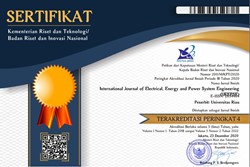Short-Term Electricity Load Forecasting Model Based DSARIMA
Abstract
Forecasting short-term electrical load is very important so that the quality of the electrical power supplied can be maintained properly. The study was conducted to measure the results of electrical load forecasting based on parameter estimates and the presentation of time series data. It is important to manage stationary data, both in terms of mean and variance. Data presentation is done by determining the value of variance through the Box-Cox transformation method and the mean value based on the ACF and PACF plots. This study considers the pattern of electricity consumption which contains double seasonal patterns. The results of previous studies show the electric power prediction model, the DSARIMA model with a MAPE of 2.06%. The condition of the model used to predict the electrical load still has a tendency not to be normally distributed and it is estimated that there are outliers. Improvements to the AR and MA parameters that meet the standard error tolerance value of 5 percent are increased in this study. The results showed improvement of parameters to predict electrical load with DSARIMA model. The significance of this study was obtained by the MAPE value of 1.56 percent when compared to the actual data.
References
M. D. Kartikasari and A. R. Prayogi, “Demand forecasting of electricity in Indonesia with limited historical data,” 2018.
M. A. Hammad, B. Jereb, B. Rosi, and D. Dragan, “Methods and Models for Electric Load Forecasting: A Comprehensive Review,” Logist. Sustain. Transp., 2020.
Y. Ardilla and S. Suhartono, “Short Term Forecasting of Electricity Load: A Comparison of Methods to Paiton Subsystem East Java & Bali,” J. Inf. Technol. Comput. Sci., 2019.
E. N. Yaqin et al., “Short Term Load Forecasting for Weekends in Indonesia: Comparison of Three Methods,” 2018.
S. A. W. Dinata, M. Azka, M. Faisal, Suhartono, R. Yendra, and M. D. H. Gamal, “Short-Term Load Forecasting Double seasonal ARIMA Methods: An Evaluation Based on Mahakam-East Kalimantan Data,” 2020.
Q. W. Luthuli and K. A. Folly, “Short term load forecasting using artificial intelligence,” 2016.
K. D. Abeyrathna and C. Jeenanunta, “Hybrid particle swarm optimization with genetic algorithm to train artificial neural networks for short-term load forecasting,” Int. J. Swarm Intell. Res., 2019.
J. Buitrago and S. Asfour, “Short-term forecasting of electric loads using nonlinear autoregressive artificial neural networks with exogenous vector inputs,” Energies, 2017.
A. Azadeh, S. F. Ghaderi, M. Sheikhalishahi, and B. P. Nokhandan, “Optimization of Short Load Forecasting in Electricity Market of Iran Using Artificial Neural Networks,” Optim. Eng., 2014.
N. Mohamed, M. H. Ahmad, Suhartono, and Z. Ismail, “Improving short term load forecasting using double seasonal arima model,” World Appl. Sci. J., 2011.
I. Mado, A. Soeprijanto, and Suhartono, “Applying of double seasonal arima model for electrical power demand forecasting at pt. pln gresik Indonesia,” Int. J. Electr. Comput. Eng., 2018.
X. Gao, X. Li, B. Zhao, W. Ji, X. Jing, and Y. He, “Short-term electricity load forecasting model based on EMD-GRU with feature selection,” Energies, 2019.
E. R. Ziegel, G. Box, G. Jenkins, and G. Reinsel, “Time Series Analysis, Forecasting, and Control,” Technometrics, 1995.
S. C. Hillmer and W. W. S. Wei, “Time Series Analysis: Univariate and Multivariate Methods.,” J. Am. Stat. Assoc., 1991.
G. E. P. Box and D. R. Cox, “An Analysis of Transformations,” J. R. Stat. Soc. Ser. B, 1964.
Copyright (c) 2022 Ismit Mado, Antonius Rajagukguk, Aris Triwiyatno, Arif Fadllullah

This work is licensed under a Creative Commons Attribution-NonCommercial 4.0 International License.


















